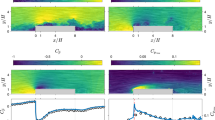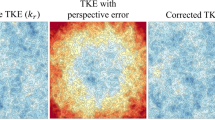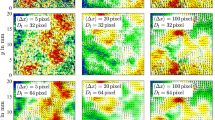Abstract
Experimental dual plane particle image velocimetry (PIV) data are assessed using direct numerical simulation (DNS) data of a similar flow with the aim of studying the effect of averaging within the interrogation window. The primary reason for the use of dual plane PIV is that the entire velocity gradient tensor and hence the full vorticity vector can be obtained. One limitation of PIV is the limit on dynamic range, while DNS is typically limited by the Reynolds number of the flow. In this study, the DNS data are resolved more finely than the PIV data, and an averaging scheme is implemented on the DNS data of similar Reynolds number to compare the effects of averaging inherent to the present PIV technique. The effects of averaging on the RMS values of the velocity and vorticity are analyzed in order to estimate the percentage of turbulence intensity and enstrophy captured for a given PIV resolution in turbulent boundary layers. The focus is also to identify vortex core angle distributions, for which the two-dimensional and three-dimensional swirl strengths are used. The studies are performed in the logarithmic region of a turbulent boundary layer at z + = 110 from the wall. The dual plane PIV data are measured in a zero pressure gradient flow over a flat plate at Re τ = 1,160, while the DNS data are extracted from a channel flow at Re τ = 934. Representative plots at various wall-normal locations for the RMS values of velocity and vorticity indicate the attenuation of the variance with increasing filter size. Further, the effect of averaging on the vortex core angle statistics is negligible when compared with the raw DNS data. These results indicate that the present PIV technique is an accurate and reliable method for the purposes of statistical analysis and identification of vortex structures.












Similar content being viewed by others
References
Adrian RJ, Christensen KT, Liu Z-C (2000a) Analysis and interpretation of instantaneous turbulent velocity fields. Exp Fluids 29:275–290
Adrian RJ, Meinhart CD, Tomkins CD (2000b) Vortex organization in the outer region of the turbulent boundary layer. J Fluid Mech 422:1–54
del Álamo JC, Jiménez J, Zandonade P, Moser RD (2004) Scaling of the energy spectra of turbulent channels. J Fluid Mech 500:135–144
Ganapathisubramani B (2004) Investigation of turbulent boundary layer structure using stereoscopic particle image velocimetry. Ph.D. thesis, University of Minnesota
Ganapathisubramani B, Longmire EK, Marusic I (2003) Characteristics of vortex packets in turbulent boundary layers. J Fluid Mech 478:35–46
Ganapathisubramani B, Longmire EK, Marusic I, Pothos S (2005a) Dual-plane PIV technique to determine the complete velocity gradient tensor in a turbulent boundary layer. Exp Fluids 39:222–231
Ganapathisubramani B, Hutchins N, Hambleton WT, Longmire EK, Marusic I (2005b) Investigation of large-scale coherence in a turbulent boundary layer using two-point correlations. J Fluid Mech 524:57–80
Ganapathisubramani B, Longmire EK, Marusic I (2006) Experimental investigation of vortex properties in a turbulent boundary layer. Phys Fluids 18:055105
Hoyas S, Jiménez J (2006) Scaling of the velocity fluctuations in turbulent channels up to Re τ = 2003. Phys Fluids 18:011702
Kähler CJ (2004) Investigation of the spatiotemporal flow structure in the buffer region of a turbulent boundary layer by means of multiple plane stereo PIV. Exp Fluids 36:114–130
Kim J, Moin P, Moser RD (1987) Turbulence statistics in fully developed channel flow at low Reynolds number. J Fluid Mech 177:133–166
Ligrani PM, Bradshaw P (1987) Spatial resolution and measurement of turbulence in the viscous sublayer using subminiature hot-wire probes. Exp Fluids 5:407–417
Marusic I (2001) On the role of large-scale structures in wall turbulence. Phys Fluids 13(3):735–743
Marusic I, Perry AE (1995) A wall wake model for the turbulent structure of boundary layers. Part 2. Further experimental support. J Fluid Mech 298:389–407
Moin P, Mahesh K (1998) Direct numerical simulation: a tool in turbulence research. Annu Rev Fluid Mech 30:539–578
Moin P, Spalart P (1987) Contributions of numerical simulation databases to the physics, modeling, and measurement of turbulence. Technical report TM10022 NASA
Perry AE, Marusic I (1995) A wall wake model for the turbulent structure of boundary layers. Part 1. Extension of the attached eddy hypothesis. J Fluid Mech 298:361–388
Pompeo L, Thomann H (1993) Quadruple hotwire probes in a simulated wall flow. Exp Fluids 14:145–152
Suzuki Y, Kasagi N (1992) Evaluation of hot-wire measurements in wall shear turbulence using a direct numerical simulation database. Exp Therm Fluid Sci 5:69–77
Theodorsen T (1952) Mechanism of turbulence. In: Proceedings of the second Midwestern conference on fluid mechanics, March 17–19
Zhou J, Adrian RJ, Balachandar S, Kendall TM (1999) Mechanisms for generating coherent packets of hairpin vortices in channel flow. J Fluid Mech 387:353–396
Acknowledgements
The authors would like to express sincere thanks to Prof. Robert Moser for providing the DNS data for the channel flow. We are indebted to Dr. Bharathram Ganapathisubramani, Pramod Subbareddy and Dr. Nicholas Hutchins for their help in using the PIV and DNS datasets and many discussions during the course of this study. Support from the National Science Foundation through Grant CTS-0324898 and from the David and Lucile Packard Foundation is gratefully acknowledged.
Author information
Authors and Affiliations
Corresponding author
Appendix: Effect of filter size on RMS statistics
Appendix: Effect of filter size on RMS statistics
The following section provides plots of the RMS values of velocity, vorticity and the Reynolds shear stress in the logarithmic, viscous buffer and outer regions of a turbulent boundary layer (Figs. 13, 14, 15, 16). These results can be used to estimate the percentage of turbulence intensity or enstrophy captured or lost for a given PIV interrogation resolution across turbulent boundary layers.
In all of the following plots, the normalization is done using the corresponding RMS value computed from the fully resolved DNS data set. RMS values of the various quantities at different wall-normal locations from the fully resolved DNS data are shown in Table 2. For the calculation of streamwise and spanwise derivatives in the wall-normal direction, a first-order approximation using two planes separated by Δz + = 21 is used, consistent with the description in Sect. 3. It must be noted that at the wall-normal location z + = 15, the effect of spacing between the planes can be seen clearly from the large drop in values of the vorticity components containing wall-normal gradients.
Rights and permissions
About this article
Cite this article
Saikrishnan, N., Marusic, I. & Longmire, E.K. Assessment of dual plane PIV measurements in wall turbulence using DNS data. Exp Fluids 41, 265–278 (2006). https://doi.org/10.1007/s00348-006-0168-z
Received:
Revised:
Accepted:
Published:
Issue Date:
DOI: https://doi.org/10.1007/s00348-006-0168-z








